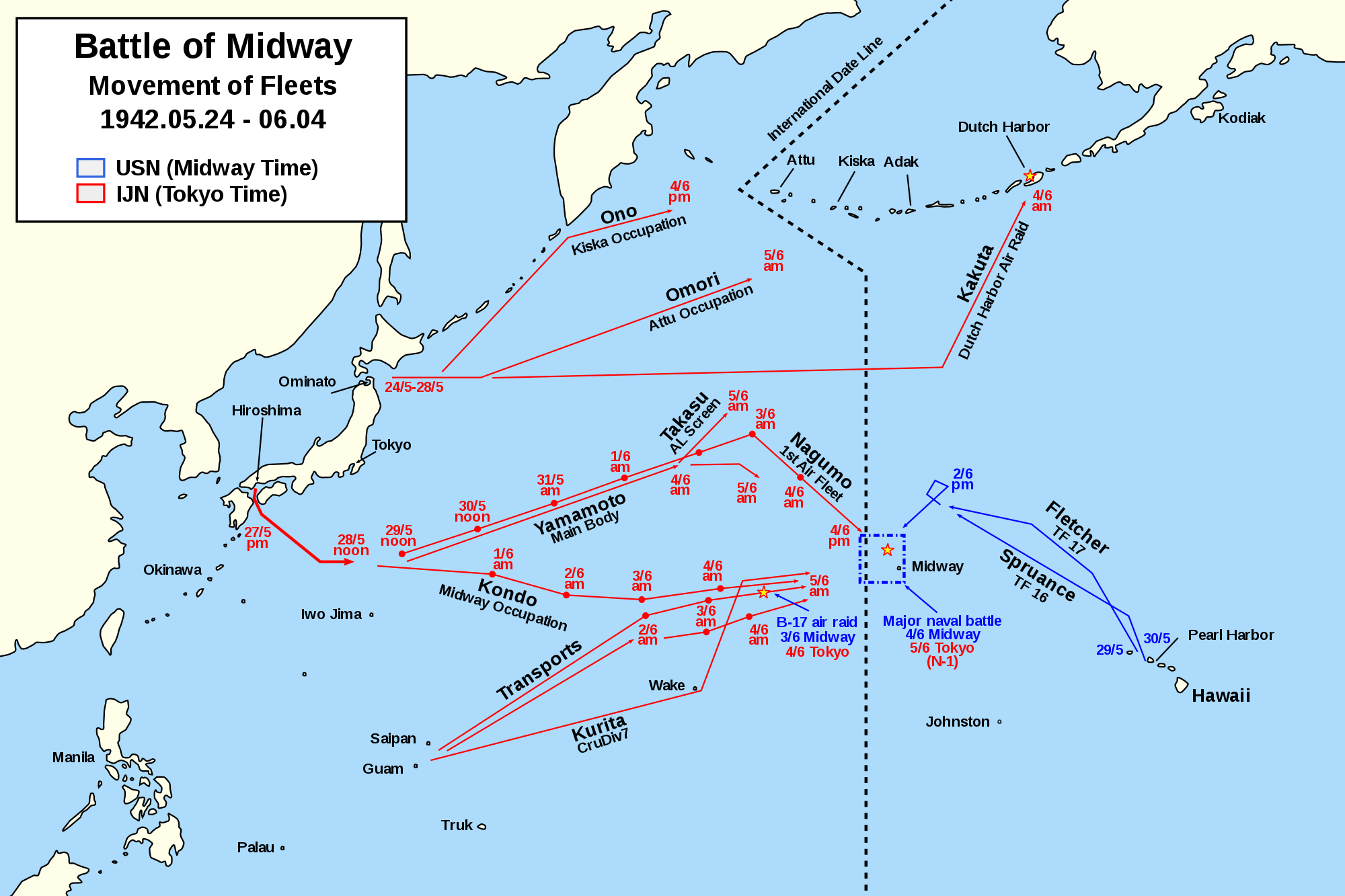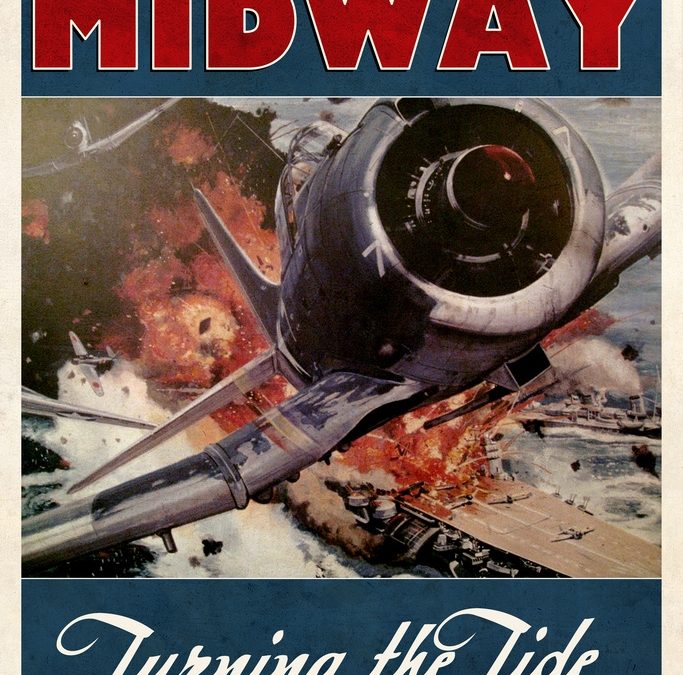Recently while teaching a DreyerCoaching.com advanced writing class, the students read my blog post about Pearl Harbor. I had asked the students to read it and pay particular attention to how I’d chosen to organize the post. (Primarily Q&A format with a personal story at the end.) To help the students improve their own writing skills, I asked them to choose their own event or period from history, write about it, and include “what if this event had never happened, or had turned out the other way.” (In my post, I’d asked “What if Japan had never attacked Pearl Harbor?” Interesting to ponder!) So, to help foster higher-level thinking and a deeper appreciation of history, I asked the students to include the same analysis in their papers.)
One student wrote about the Battle of Midway. In many ways, this battle was a big step after Pearl Harbor, as well as the turning point in the Pacific Theater of WW II, so I am DELIGHTED to add this blog post on the topic!
Midway
Turning point. This accurately describes the Battle of Midway, one of the most decisive battles in the warfare of the Pacific during WWII. It not only halted the Japanese dominance in the Pacific, it reduced the potential losses of the American forces. Needless to say, the Battle of Midway is one of the most studied battles in recent history, not only because of its surprising result, but the strategies involved. Excited by its “victory” at Pearl Harbor six months earlier, Japan decided to launch another attack on the American navy by baiting them in at Midway, a small American island that was vital to the defense of Hawaii. However, Japan lost. How? The Imperial Japanese Navy (IJN) made three fatal mistakes: first, they were discussing the specifics of their plan through radio, which were picked up and decoded by the Americans; second, their forces were split apart too far to be effective against counterattack; last, their plan was based on a fallacious assumption on the availability of American carriers.
First, their message was overheard by the Americans. Prior to the Battle of Midway, the American military broke the Japanese naval code (JN-25). This gave them a significant edge and proved to be pivotal to the Americans’ preparation, winning them the tide-turning battle in the Pacific. The fatal mistake made by the Japanese was to disclose too much of their plan through the radio. Of course, Japanese commanders were completely unaware of the US military’s access to their encoded messages, but these messages became decisive in aiding the US to plan out a counterattack against the Japanese ambush. Perhaps the human error of Japan was to include the specific date and place of the attack in the Pacific on the radio. They could have taken a much safer route of communication, to ensure the message was passed secretly between Marshal Admiral Yamamoto and his colleagues. The result of this leak was significant. The Americans, knowing their exact location and time of the attack, were much more prepared than their unknowing opponent, and prepared an ambush that ravaged the Japanese navy, which caused irreversible harms in terms of carriers and pilots.
Second, the Japanese split their forces apart, resulting in miscommunication and ineffectiveness. Originally, the Japanese force was split into four sections, encompassing a wide region, to surround the American force and ambush them from all directions while they were busy fighting the “bait” at Midway. This was a viable strategy, which was ultimately meticulously planned. However, this strategy had two major downfalls. The first is that it was built on the assumption that the aircraft carrier the Yorktown suffered irreparable damage, rendering it to not able to fight. However, this is not true, and the Yorktown proved to play a pivotal role. The second downfall is the US interception of Japanese plan, which turned Japan’s devious plan of ambush into a weak formation. Mark Peattie, an expert on recent war history and Japanese military, dubbed the Japanese naval force as “glass jaw: it could throw a punch but couldn’t take one.” This split formation allowed the American force, which was originally weaker than the combined Japanese navy, to have an edge as it fights each forced one by one. The miscommunication between the sections also attributed to the US victory, allowing them to take out four Japanese aircraft carriers with only two and a half carriers in action (the Yorktown had only been partially repaired after its damage at Pearl Harbor).
Lastly, the Japanese made a false assumption about the availability of the aircraft carrier Yorktown. During the planning stages of the Battle of Midway, the Japanese Admiral Yamamoto thought that the only two major American carriers in the Pacific were USS Enterprise and USS Hornet. This caused them to underestimate the firepower of their American foe, and devise a rather risky plan that requires delicate coordination between the split task forces. However, with one more carrier than expected available, the Americans were able to turn the tables. Though severely damaged in the Battle of Coral Sea, the USS Yorktown was still repairable. The presence of the Yorktown gave the American task force much more power and played a pivotal role in discovery and destruction of the Japanese fleet at Midway.

In conclusion, the Americans secured their first victory in Pacific warfare because of a multitude of reasons, but mostly because of three fatal mistakes made by Japan: information leakage, battle miscommunication, and underestimating the American force. This victory secured the United States’s foothold in the Pacific region, and pushed Japan to the edge of the cliff, greatly affecting the later battles in the same region. Japan’s inability to recover from this loss indirectly affected the end result of WWII and changed history forever.
What if the US had lost?
Presumably, if the US had lost the Battle of Midway, not only would they have lost all three of their aircraft carriers active in the Pacific region, they would have also lost their grip on the area, allowing the Japanese forces to control the Pacific with relative ease. This might have complicated the war, and applied great pressure on the US’s Pacific front. However, in the greater scheme of things, the outcome of the war would not have changed, as the development of the atom bomb would not have been halted, and the Japanese surrender would have been inevitable.
–Tim in Hsinchu, Taiwan
***********
Do you want help with your writing, in a small group or 1 on 1? We help all students, all levels, child to adult! Contact Scott today!
Since 2010, based in the friendly USA State of Virginia, DreyerCoaching.com has been providing customized, high-quality, real-time language instruction via the internet to a global audience in their home, school, or office. Think how comfortable, confident and successful you or your child will feel, receiving personalized guidance from college-educated teachers who are native speakers and have bachelor’s, master’s, and doctoral degrees plus decades of teaching experience. Whether you are looking for help with the ABCs or the SATs, or college admissions to conversational English to business writing, we serve all ages and levels to help our students make dreams come true. Discover the Dreyer Difference. Take the first step and visit DreyerCoaching.com, send Scott an email, or schedule a free consultation to get started.
自 2010 年以来,DreyerCoaching.com 总部位于友好的美国弗吉尼亚州,一直通过互联网向全球观众在家中、学校或办公室提供有制度的、高质量的实时语言教学。 想想您或您的孩子会感到多么自在、自信和成功,从受过大学教育的教师那里获得个别的指导,这些教师都是以英语为母语,拥有学士、硕士和博士学位,以及数十年的教学经验的教师。 无论是从 英语ABC的基础课程 或 SAT 的帮助,就读美国高中,大学入学申请,还是从会话英语到商务写作,我们都为所有年龄和水平的学生提供服务,帮助我们的学生实现梦想。 发觉 Dreyer 的不同之处。 迈出第一步,游览 DreyerCoaching.com网站,向 Scott 发送电子邮件,可开始安排一个免费咨询。


